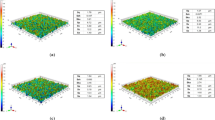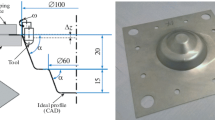Abstract
Self-piercing riveting has gained relevance in the automotive industry as an alternative method to resistance spot welding for the joining of two or more metal sheets. Its simulation via the finite element method, which includes large deformation, plasticity, and fracture mechanics phenomena, has been previously studied in depth. However, costly experimental tests are still required for the characterization of several uncertain variables such as the mechanical properties of all materials, or the friction coefficients of all existing contact pairs. This paper proposes a machine learning model, which can be trained with both experimental and numerical data, in order to predict the cross-sectional features of the riveted joint from the corresponding punch force-displacement curves, such as the interlock distance or the minimum thickness of the lower sheet. In order to achieve this goal, a parametric study has been first carried out by means of a finite element model, by varying the mechanical properties of the upper and lower sheet materials as well as the friction coefficients, while keeping constant the rivet material and all geometries involved. All the obtained force-displacement curves, defined by a large number of points, have been initially projected to a lower-dimensional space via a convolutional autoencoder. Then, a multilayer perceptron has been used to associate their latent space to their corresponding final geometric features. It was found that there is a strong correlation between the force-displacement curves and the final geometric features, allowing for further studies including variation in the geometry or in the rivet material.












Similar content being viewed by others
References
Abe Y, Kato T, Mori K (2006) Joinability of aluminium alloy and mild steel sheets by self piercing rivet. J Materials Process Technol 177(3):417–421
He X, Pearson I, Young K (2008) Self-pierce riveting for sheet materials: State of the art. J Materials Process Technol 199(3):27–36
Soomro IA, Pedapati SR, Awang M (2022) A review of advances in resistance spot welding of automotive sheet steels: emerging methods to improve joint mechanical performance. Int J Adv Manuf Technol 118:1335–1366
Qin DL, Chen C (2022) Failure behavior and mechanical properties of novel dieless clinched joints with different sheet thickness ratios. J Cent South Univ 29(9):3077–3087
Zhang X, Chen C (2022) Experimental investigation of joining aluminum alloy sheets by stepped mechanical clinching. J Mater Res Technol 19(7):566–577
Ren X, Chen C (2023) Research on mechanical clinching process for dissimilar aluminum alloy sheets with inclined surface. J Manuf Process 89:362–370
Ouyang X, Chen C (2023) Research on the joining of aluminum alloy and high-strength steel by dieless clinched-adhesive processes. J Mater Res Technol 24(5):5526–5540
Lennon R, Pedreschi R, Sinha BP (1999) Comparative study of some mechanical connections in cold formed steel. Constr Build Mater 13:109–116
Cai W, Wang PC, Yang W (2005) Assembly dimensional prediction for self-piercing riveted aluminum panels. Int J Machine Tools Manuf 45(3):695–704
Sun X, Stephens EV, Khaleel MA (2007) Fatigue behaviors of self-piercing rivets joining similar and dissimilar sheet metals. Int J Fatigue 29(3):370–386
He X (2010) Recent development in finite element analysis of clinched joints. Int J Adv Manuf Technol 48:607–612
Li B, Fatemi A (2006) An experimental investigation of deformation and fatigue behavior of coach peel riveted joints. Int J Fatigue 28(3):9–18
Atzeni E, Ippolito R, Settineri L (2009) Experimental and numerical appraisal of self-piercing riveting. CIRP Annals 58(3):17–20
Hoang NH, Hopperstad OS, Langseth M, Westermann I (2013) Failure of aluminium self-piercing rivets: An experimental and numerical study. Mater Design 49(3):323–335
Hönsch F, Domitner J, Sommitsch C, Götzinger B, Kölz M (2018) Numerical simulation and experimental validation of self-piercing riveting (spr) of 6xxx aluminium alloys for automotive applications. J Phys: Confer Series 1063:3
Ren X-Q, Chen C, Ran X-K, Li Y-X, Zhang X-G (2021) Microstructure evolution of aa5052 joint failure process and mechanical performance after reconditioning with tubular rivet. Trans Nonferrous Metals Soc China 31:3380–3393
Atzeni E, Ippolito R, Settineri L (2007) Fem modeling of self-piercing riveted joint. Key Eng Mater 344(3):655–662
Porcaro R, Hanssen AG, Langseth M, Aalberg A (2006) Self-piercing riveting process: An experimental and numerical investigation. J Mater Process Technol 171(3):10–20
Daoud M, Gomes R, Kohout N, Balan T (2021) Effect of material behavior on dissimilar metal self-piercing riveting parameters based on finite element modeling for automotive applications. SIA Simulation Numérique Conference Proceedings
Karathanasopoulos N, Pandya KS, Mohr D (2021) Self-piercing riveting process: Prediction of joint characteristics through finite element and neural network modeling. J Adv Join Process 3(3):100040
Karathanasopoulos N, Mohr D (2022) Strength and failure of self-piercing riveted aluminum and steel sheet joints: Multi-axial experiments and modeling. J Adv Join Process 5(3):100107
Casalino G, Rotondo A, Ludovico A (2008) On the numerical modelling of the multiphysics self piercing riveting process based on the finite element technique. Adv Eng Softw 39(3):787–795
Haykin SO (2010) Neural Networks and Learning Machines. Pearson Education, Limited, 3rd edition ed
Brunton SL, Kutz JN (2019) Data-Driven Science and Engineering. Cambridge University Press, 3
Zhao H, Han L, Liu Y, Liu X (2021) Quality prediction and rivet/die selection for spr joints with artificial neural network and genetic algorithm. J Manuf Process 66(3):574–594
Fang Y, Huang L, Zhan Z, Huang S, Liu X, Chen Q, Zhao H, Han W (2022) A framework for calibration of self-piercing riveting process simulation model. J Manuf Process 76(3):223–235
Jain V, Seung HS (2008) Natural image denoising with convolutional networks. Advances in Neural Information Processing Systems 21 (NIPS 2008)
Rumelhart DE, Hinton GE, Williams RJ (1988) Learning internal representations by error propagation. Readings Cogn Sci 3:399–421
Baldi P (2021) Deep Learning in Science. Cambridge University Press
Goodfellow IJ, Pouget-Abadie J, Mirza M, Xu B, Warde-Farley D, Ozair S, Courville A, Bengio Y (2014) Generative adversarial nets
Oh S, Kim HK, Jeong TE, Kam DH, Ki H (2020) Deep-learning-based predictive architectures for self-piercing riveting process. IEEE Access 8:116254–116267
Kim HK, Oh S, Cho KH, Kam DH, Ki H (2021) Deep-learning approach to the self-piercing riveting of various combinations of steel and aluminum sheets. IEEE Access 9:79316–79325
von Mises R (1928) Mechanik der plastischen formänderung von kristallen. ZAMM - Z Angew Math Mech 8(3):161–185
Mohr D, Marcadet SJ (2015) Micromechanically-motivated phenomenological hosford-coulomb model for predicting ductile fracture initiation at low stress triaxialities. Int J Solids Struct 67–68(3):40–55
Peng J, Zhou P, Wang Y, Dai Q, Knowles D, Mostafavi M (2021) Stress triaxiality and lode angle parameter characterization of flat metal specimen with inclined notch. Metals 11(2):1627
Kramer MA (1991) Nonlinear principal component analysis using autoassociative neural networks. AIChE J 37(3):233–243
He X, He Q, Chen J-S (2022) Deep autoencoders for physics-constrained data-driven nonlinear materials modeling. Comput Methods Appl Mech Eng 385:3
Goodfellow I, Bengio Y, Courville A (2016) Deep learning. MIT Press
McKay MD, Beckman RJ, Conover WJ (1979) A comparison of three methods for selecting values of input variables in the analysis of output from a computer code. Technometrics 21(3):239
Funding
This work was conducted with the help of the French Technological Research Institute for Materials, Metallurgy and Processes (IRT-M2P). The authors would like to acknowledge IRT-M2P and the partners of the project RESEM4 led by IRT-M2P
Author information
Authors and Affiliations
Contributions
All authors contributed to the study conception and design. Simulations, data collection and analysis were performed by B. Ferrándiz and M. Daoud. The first draft of the manuscript was written by B. Ferrándiz and all authors commented on previous versions of the manuscript. All authors read and approved the final manuscript
Corresponding author
Ethics declarations
Competing interests
The authors declare no competing interests.
Additional information
Publisher's Note
Springer Nature remains neutral with regard to jurisdictional claims in published maps and institutional affiliations.
Rights and permissions
Springer Nature or its licensor (e.g. a society or other partner) holds exclusive rights to this article under a publishing agreement with the author(s) or other rightsholder(s); author self-archiving of the accepted manuscript version of this article is solely governed by the terms of such publishing agreement and applicable law.
About this article
Cite this article
Ferrándiz, B., Daoud, M., Kohout, N. et al. Prediction of cross-sectional features of SPR joints based on the punch force-displacement curve using machine learning. Int J Adv Manuf Technol 128, 4023–4034 (2023). https://doi.org/10.1007/s00170-023-12102-9
Received:
Accepted:
Published:
Issue Date:
DOI: https://doi.org/10.1007/s00170-023-12102-9




